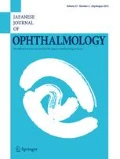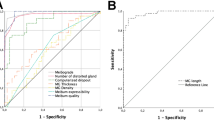Abstract
Purpose
To evaluate diagnostic criteria for obstructive meibomian gland dysfunction (MGD) using three parameters (symptom score, lid margin abnormality score, and meibomian gland morphologic change scores) for differentiating obstructive MGD from aqueous deficiency dry eye (ADDE).
Methods
Twenty-five eyes of 25 patients (mean age, 66.6 years) diagnosed with obstructive MGD and 15 eyes of 15 patients (mean age, 61.3 years) diagnosed with ADDE were analyzed. Ocular symptoms were scored from 0 to 14 according to the number of symptoms. Lid margin abnormality was scored from 0 to 4 according to the number of abnormalities. Meibomian gland changes were scored from 0 to 6 using noncontact meibography (meibo-score). Superficial punctate keratopathy was scored from 0 to 3. Meibum was graded from 0 to 3 according to volume and quality. Tear film break-up time was measured consecutively three times after instillation of fluorescein, and the median value was adopted. Tear film production was evaluated using the Schirmer test.
Results
Ocular symptom and lid margin abnormality scores and tear film break-up time did not differ significantly between the obstructive MGD and ADDE groups. The meibum score and meibo-score were significantly higher in the obstructive MGD group than in the ADDE group. The Schirmer value was significantly lower in the ADDE group than in the obstructive MGD group. When obstructive MGD was diagnosed on the basis of three scores (ocular symptom score, lid margin abnormality score, and meibo-score) all being abnormal, the sensitivity and specificity for differentiating between obstructive MGD and ADDE were 68.0% and 80%, respectively.
Conclusions
Although the criteria were moderately reliable for differentiating patients with obstructive MGD from those with ADDE when the diagnosis of obstructive MGD was made on the basis of three abnormal scores, they do not provide comprehensive diagnostic tools for differentiating MGD, ADDE, and healthy individuals. We need to add other parameters such as the Schirmer test value and the meibum score to the diagnostic criteria to enhance their reliability for differentiating MGD and ADDE.
Similar content being viewed by others
References
Mishima S, Maurice DM. The oily layer of the tear film and evaporation from the corneal surface. Exp Eye Res 1961;1:39–45.
McCulley JP. Meibomitis. In: Kaufman HE, Barron BA, McDonald MB, Waltman SR, editors. The cornea. New York: Churchill Livingstone; 1988. p. 125–138.
Lemp MA. Report of the National Eye Institute/Industry Workshop on Clinical Trials in Dry Eyes. CLAO J 1995;21:221–232.
Mathers WD. Ocular evaporation in meibomian gland dysfunction and dry eye. Ophthalmology 1993;100:347–351.
Shimazaki J, Sakata M, Tsubota K. Ocular surface changes and discomfort in patients with meibomian gland dysfunction. Arch Ophthalmol 1995;113:1266–1270.
Lee SH, Tseng SCG. Rose Bengal staining and cytologic characteristics associated with lipid tear deficiency. Am J Ophthalmol 1997;124:736–750.
Arita R, Itoh K, Maeda S, et al. Proposed diagnostic criteria for obstructive meibomian gland dysfunction. Ophthalmology 2009;116:2058–2063.
Arita R, Itoh K, Inoue K, Amano S. Noncontact infrared meibography to document age-related changes of the meibomian glands in a normal population. Ophthalmology 2008;115:911–915.
Shimazaki J, Goto E, Ono M, et al. Meibomian gland dysfunction in patients with Sjögren syndrome. Ophthalmology 1998;105:1485–1488.
Toda I, Fujishima H, Tsubota K. Ocular fatigue is the major symptom of dry eye. Acta Ophthalmol 1993;71:347–352.
Author information
Authors and Affiliations
Corresponding author
Additional information
Drs. Arita and Amano are applying with Topcon for a patent for the meibography technique described in this manuscript.
About this article
Cite this article
Arita, R., Itoh, K., Maeda, S. et al. Efficacy of diagnostic criteria for the differential diagnosis between obstructive meibomian gland dysfunction and aqueous deficiency dry eye. Jpn J Ophthalmol 54, 387–391 (2010). https://doi.org/10.1007/s10384-010-0858-1
Received:
Accepted:
Published:
Issue Date:
DOI: https://doi.org/10.1007/s10384-010-0858-1




